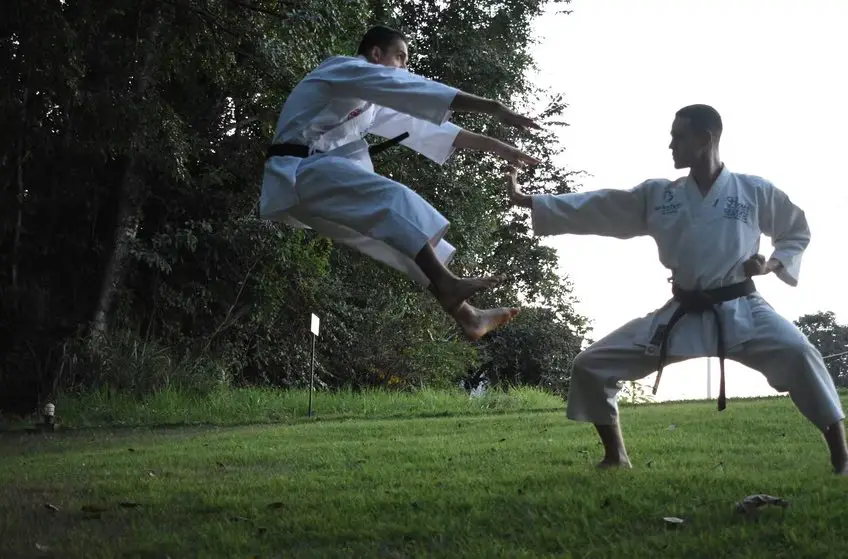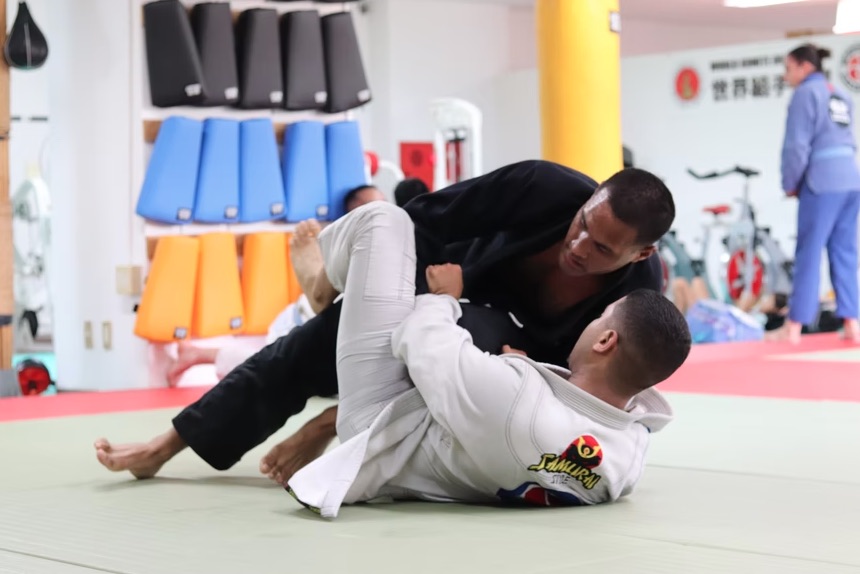Brazilian Jiu-Jitsu (BJJ) is a transformative martial art beyond self-defence, offering physical fitness, mental resilience, and personal growth.
With a focus on technique over strength, BJJ teaches strategic thinking and problem-solving while fostering self-discipline, patience, and a supportive community.
Each training session is a journey in self-awareness and continuous learning, providing tools for physical health and a resilient mindset that is valuable both on and off the mat.
Let's get straight to the point
Brazilian Jiu-Jitsu (BJJ) is a martial art focused on self-defence, fitness, and personal growth. It emphasises technique over strength, using control and ground-fighting skills to neutralise opponents.
BJJ builds physical fitness—enhancing strength, flexibility, and endurance—while promoting mental resilience through problem-solving and focus.
Beyond training, BJJ fosters a supportive community and teaches discipline, self-control, and patience. Practitioners gain stress relief, confidence, and a growth mindset, making BJJ a holistic path for self-improvement and a healthier lifestyle.
1. BJJ Teaches Practical Self-Defence Techniques

Brazilian Jiu-Jitsu is one of the most practical martial arts for self-defence. It focuses on ground control and submission techniques to neutralise threats.
Self-Defence Mechanisms in BJJ:
- Control Over Power: Instead of relying on physical strength, BJJ uses leverage and angles to control larger or stronger opponents.
- Ground Fighting Expertise: Most real-life fights often end on the ground. BJJ prepares practitioners to defend themselves effectively in such situations.
- Submission Holds: BJJ employs chokeholds and joint locks to subdue opponents safely, allowing a smaller individual to overcome a larger threat.
BJJ equips practitioners with the skills to defend themselves without causing unnecessary harm. For example, applying a chokehold or joint lock can force an opponent to surrender without injury, embodying "gentle art."
2. BJJ Builds Physical Fitness And Strength
In addition to self-defence, BJJ is a highly effective workout that develops strength, flexibility, and cardiovascular fitness.
Physical Benefits of BJJ Training:
- Enhanced Strength and Stamina: Practitioners develop explosive strength and endurance through drills and sparring.
- Weight Management: Regular training aids in calorie burning and muscle toning, making BJJ effective for weight loss.
- Improved Flexibility: The dynamic movements of BJJ increase flexibility, especially in the hips and core.
- Body Coordination and Balance: Practising BJJ requires coordinating movements and maintaining balance, which enhances body awareness.
BJJ training combines aerobic and anaerobic exercise, helping practitioners build lean muscle and improve overall physical health.
3. BJJ Enhances Mental Resilience And Focus
Brazilian Jiu-Jitsu is often described as “human chess,” highlighting its mental challenges. Practitioners develop a unique combination of focus, problem-solving skills, and resilience.
Mental Benefits of BJJ:
- Improved Focus: During training, practitioners must pay close attention to techniques that strengthen concentration skills.
- Problem-Solving Under Pressure: Sparring requires quick thinking and adapting to opponents’ moves, building mental agility.
- Increased Resilience: BJJ teaches perseverance through challenging situations, which builds mental toughness and the ability to stay calm under pressure.
Practising BJJ encourages persistence. Repeatedly trying to master techniques helps practitioners learn from mistakes, fostering a resilient and growth-oriented mindset.
4. BJJ Fosters A Supportive Community And Social Connections
BJJ is a personal journey and a communal experience. Training sessions foster a supportive environment where practitioners build friendships and a sense of belonging.
Social Aspects of BJJ:
- Team-Based Training: BJJ classes often involve partner drills and group activities, which build camaraderie.
- Supportive Environment: Practitioners encourage each other, creating a positive training culture.
- Diverse Community: People from all backgrounds—different ages, sizes, and skill levels—train together, enriching the community experience.
This strong sense of community makes BJJ more than just a martial art; it becomes a shared journey that helps individuals feel connected and supported.
5. BJJ Promotes Discipline And Self-Control
BJJ requires consistent practice and dedication, fostering self-discipline and a strong work ethic in its practitioners.
How BJJ Develops Discipline:
- Commitment to Regular Training: Practitioners learn the importance of showing up consistently to improve their skills.
- Respect for Training Partners: Training involves respecting others’ boundaries and teaching mutual respect and self-control.
- Emphasis on Technique Over Aggression: BJJ prioritises precision and control over aggression, encouraging practitioners to remain calm and composed.
By reinforcing these values, BJJ helps practitioners apply discipline in their training and daily lives.
6. BJJ Improves Problem-Solving Skills
Every sparring session in BJJ is a problem-solving exercise where practitioners adapt to opponents’ moves and strategise accordingly.
Problem-Solving Techniques in BJJ:
- Anticipating Opponent’s Moves: BJJ involves reading an opponent’s body language and anticipating their actions, which sharpens strategic thinking.
- Experimentation and Adaptability: Practitioners constantly adjust techniques based on what works best, which fosters creative problem-solving.
- Decision-Making Under Pressure: In a live role, decisions must be made quickly, and confidence in decision-making must be developed.
These problem-solving skills transfer beyond the mat, improving critical thinking and adaptability in various life situations.
7. BJJ Helps Manage Stress And Enhances Mental Well-being
BJJ provides a mental break from daily life, helping practitioners manage stress through physical activity and mindfulness.
Stress-Relief Benefits of BJJ:
- Physical Outlet for Stress: BJJ’s intense physical workout helps release tension and improve mood.
- Focused Mindfulness: The need to focus on technique promotes mindfulness, allowing practitioners to clear their minds of external stressors.
- Increased Confidence: Successfully learning and applying techniques builds self-confidence, contributing to a positive mental state.
Many find that stepping onto the mat relieves everyday pressures, enhancing their mental health.
8. BJJ Offers Life-Long Learning And Personal Growth
BJJ is a journey that encourages lifelong learning. Practitioners constantly learn new techniques, refine skills, and challenge themselves to improve.
Growth Mindset in BJJ:
- Continuous Skill Development: Techniques in BJJ evolve, so practitioners are always learning and adapting.
- Opportunities for Progression: The belt system in BJJ represents a journey of progress and achievement, motivating practitioners to strive for excellence.
- Reflection and Self-Awareness: BJJ promotes self-reflection, encouraging practitioners to assess their strengths and weaknesses.
This continuous journey of learning fosters a growth mindset that translates into personal and professional development.
9. BJJ Enhances Awareness Of Physical Health

Regular BJJ practice encourages practitioners to pay close attention to their physical health and well-being, fostering habits that support long-term health.
Physical Health Awareness in BJJ:
- Injury Prevention: BJJ practitioners learn techniques for safe movement, reducing the risk of injury in training and daily life.
- Nutritional Awareness: The physical demands of BJJ motivate practitioners to focus on nutrition for optimal performance.
- Understanding Body Mechanics: Practitioners develop a strong understanding of their own body, promoting better posture and alignment.
Through consistent practice, BJJ encourages practitioners to care for their bodies, helping them maintain physical health over time.
10. BJJ Teaches Patience And Perseverance
BJJ is a slow and steady journey that requires patience as practitioners develop their skills and progress through the belt system.
Building Patience Through BJJ:
- Focus on Long-Term Goals: BJJ belts take years to earn, teaching the value of patience and long-term dedication.
- Learning from Failure: Practitioners learn that failure is part of the process, encouraging them to view setbacks as learning opportunities.
- Resilience in the Face of Challenges: Each training session builds mental and physical resilience, reinforcing the importance of perseverance.
The skill development process in BJJ reinforces patience, teaching practitioners to embrace gradual progress and personal growth.
Conclusion
Brazilian Jiu-Jitsu is more than just a martial art; it’s a path to physical fitness, mental resilience, and personal growth.
Through its practical self-defence techniques, intense physical training, and focus on problem-solving and discipline, BJJ offers a comprehensive approach to self-improvement.
Each training session helps build a supportive community, enhances mental well-being, and cultivates a growth mindset that extends beyond the mat.
Whether you’re looking to enhance your strength, reduce stress, or build life skills, Brazilian Jiu-Jitsu provides a lifelong journey of learning and self-awareness.
Embracing BJJ means embracing a holistic lifestyle of discipline, patience, and continuous self-improvement—qualities that ultimately empower you in every aspect of life.
FAQs About Jui Jitsu
The basic objective of Brazilian Jiu-Jitsu is to use hands and legs to lock and immobilize the opponent. Different BJJ techniques like pull guard, close guard, scissor guard, full mount, joint locks, etc., are used to cramp the opponent, hence seizing his mobility.
BJJ is incredibly effective in fighting conditions. It allows the fighter to take control and, most importantly, finish the fight without hurting the other person. The technique is so effective that the opponent will either give up or be incapacitated. But BJJ goes way beyond the mat.
Muay Thai is fundamentally striking stand-up combat, while BJJ is ground fighting grappling combat. Muay Thai basics may be picked up very quickly, but both systems are difficult to master without years of hard work and grit truly. They are both most effective in their respective arenas under their respective rules.
If you want to learn more about balance and coordination – Choose BJJ. If you want more real-life applicability – Choose MMA. If you are younger (or a parent) and want the less violent practice – Choose BJJ. If you are older and prepared for strikes – Choose MMA.
The average time it takes to achieve this is usually around 10 years. There are some individuals like BJ Penn and Kit Dale, who have amazing rapid rises up the ranks to very high levels. But they are the exceptions to the rule.

